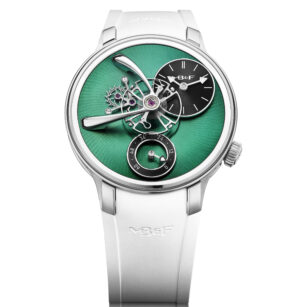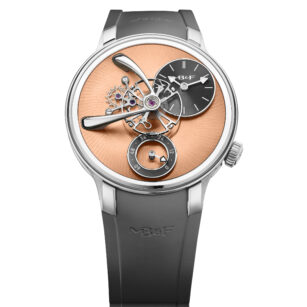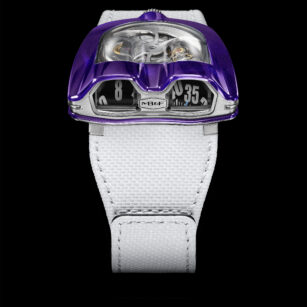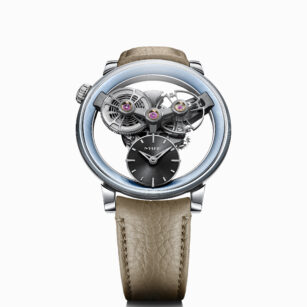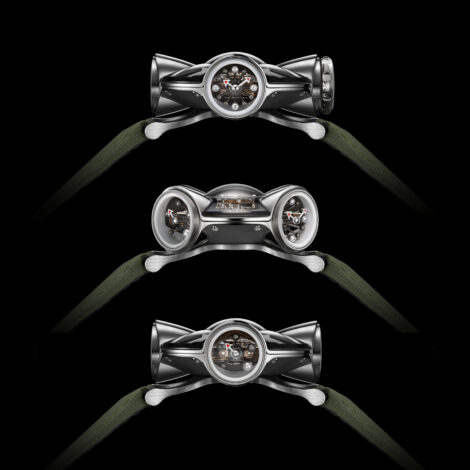
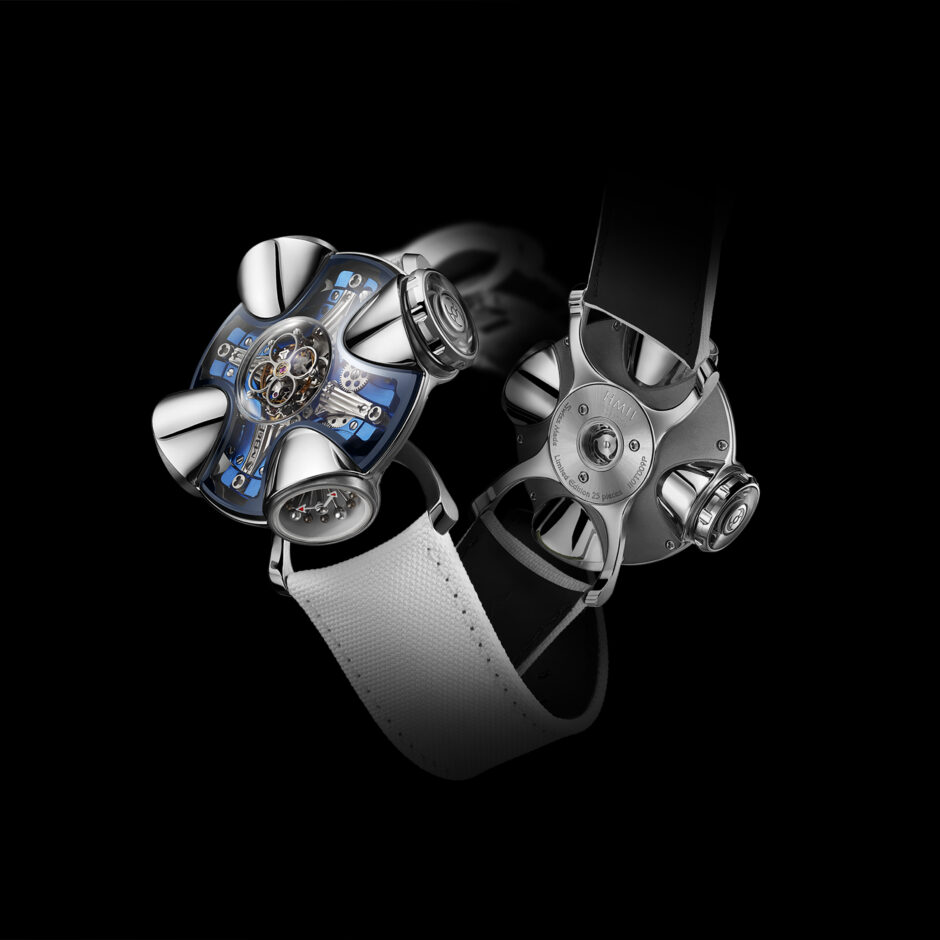
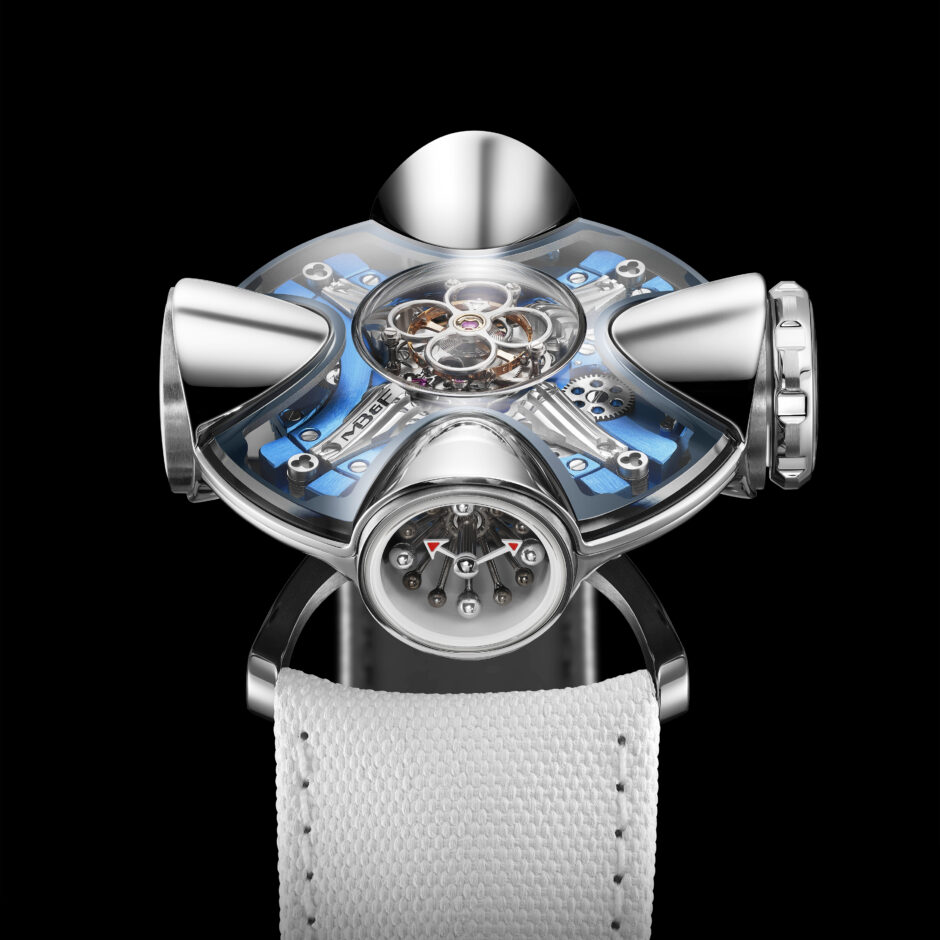
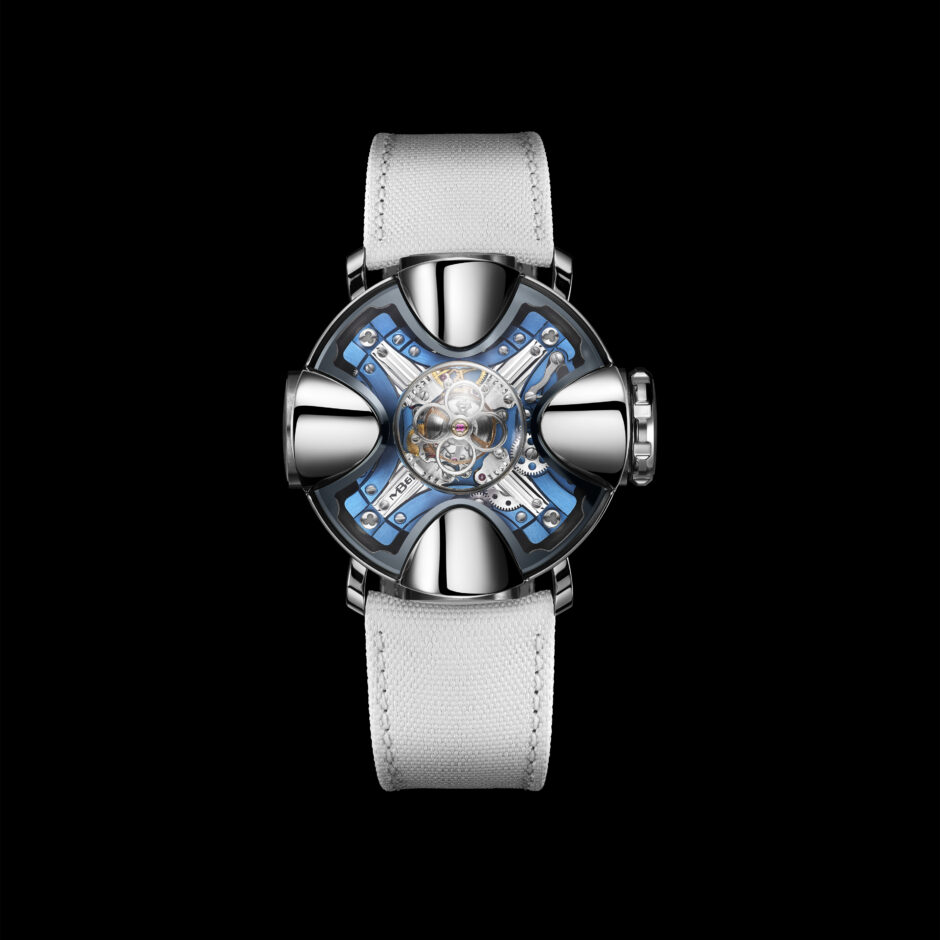
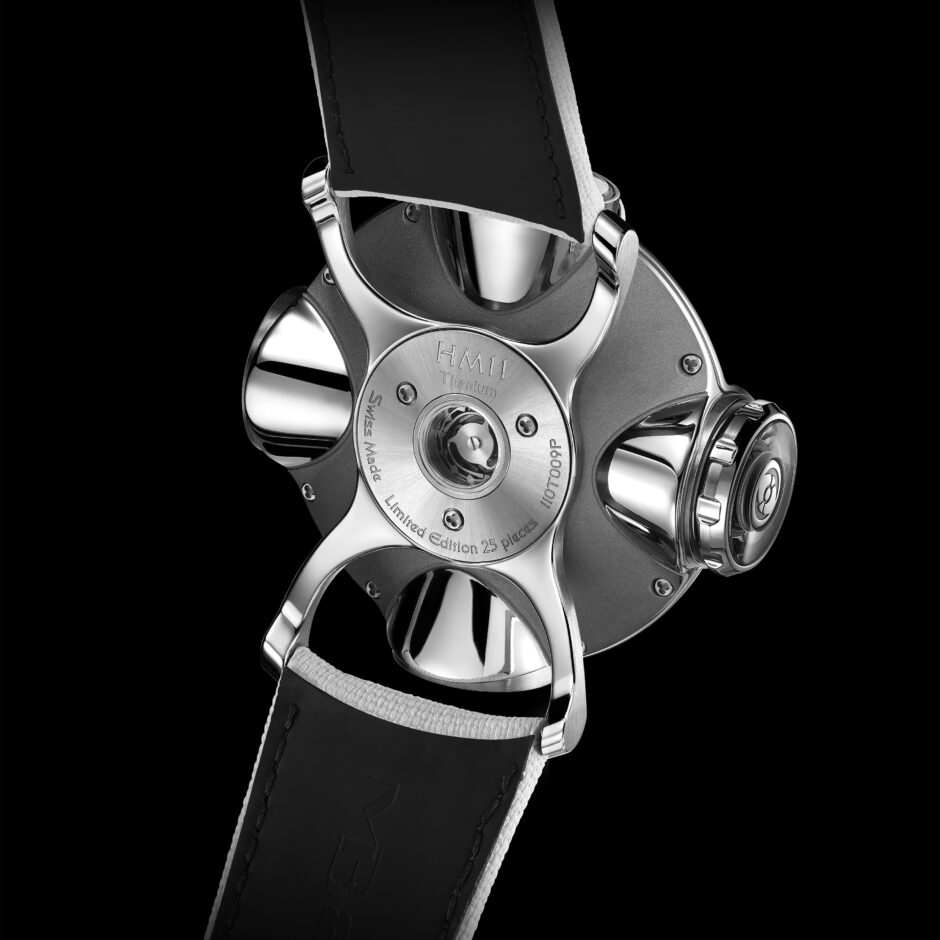




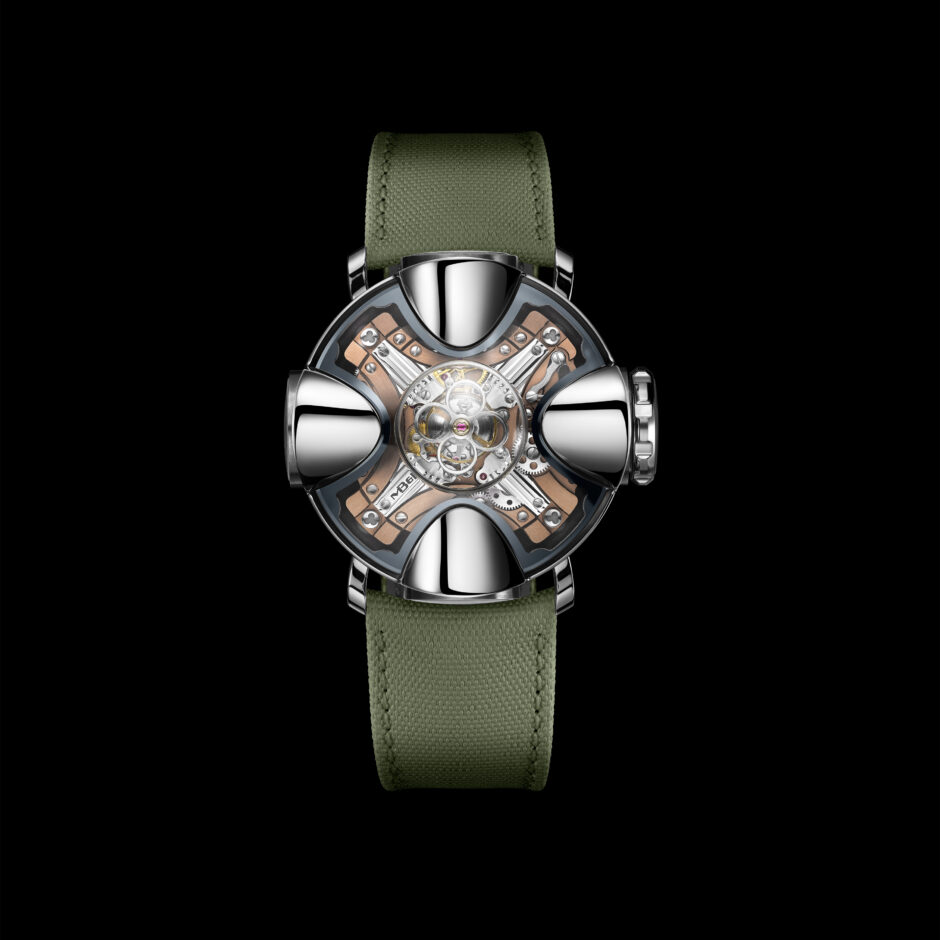

"MB&F HM11 Architect: Explore time in a watchmaker's home."

MB&F HOROLOGICAL MACHINE Nº11 ARCHITECT
“A house is a machine for living in”, said the famous Swiss architect Le Corbusier. MB&F Machines are habitable; the stories they tell transport us to other places or times, sometimes to other worlds. You could say that an MB&F Machine is not to be worn, it is to be experienced.
Not the easiest concept to grasp, since a watch is not a house, is it? A house is a house, a watch is a watch. No confusion, it’s black or it’s white, isn’t it? With its latest creation, MB&F blurs the lines even further, and the result is the gray of steel rebar, the gray of freshly pulverized concrete.
Here’s MB&F’s Horological Machine Nº11 Architect.
The house built by Max
In the mid-to-late 1960s, architecture entered an experimental phase, with concepts very different from those of the previous decade. Post-war buildings were practical and rectilinear, hastily erected to meet needs. However, a small but responsive movement began to emerge. The approach was surprisingly humanistic, but not in the sense used by architectural specialists.
It was humanistic in the sense that it modeled space on the human body, on the spherical vision of the human eye, on the radial reach of human limbs as they move through the air, on the roundness of the breath that inflates our lungs and creates ephemeral halos of vapor on car windows in winter.
These architects, some of whom prefer to be called habitologists, built houses that seemed to have breathed out of the earth, or to have been born of an earth that had folded its fingers and forgotten to unfold them completely. They bubbled, they undulated, they arched like a taut ligament. And in front of one of these houses, MB&F founder Maximilian Büsser asked himself, “What if this house were a watch?”
A central flying tourbillon forming the heart of the house rises skyward beneath a doubly domed sapphire roof. A fitting nod to a mechanism that lies spatially and functionally at the watch’s origin, the four-lobed upper bridge recalls the shape of clerestory windows in some of the greatest temples dedicated to humanity’s Creator, or perhaps the shape of a zygote undergoing cell division during conception. Four symmetrical volumes extend outwards from the rotating center to create the four parabolic rooms of the HM11 Architect house.
Each room is accessed by rotating the house: the entire structure rotates on its foundations. With a 90° angle between each room, you can place one of the rooms facing you, or one of the corridors in its direction, and the rooms at an angle on either side. This versatility of display also has practical benefits. The HM11 Architect is an energy-efficient construction – each 45° clockwise rotation, signalled by a sensitive click under the fingers, directly supplies 72 minutes of energy to the barrel. After 10 complete rotations, the HM11 reaches its maximum autonomy of 96 hours.
Although they share a similar interior – glossy white walls and a sapphire window – each of the four rooms performs a different function. In the Time Room, the hours and minutes are displayed. Rod-mounted globes serve as indexes, large, clear polished aluminum globes for the quarters, small, dark polished titanium globes for the rest. Hours and minutes are indicated by red-tipped arrows, adding an exceptional touch of color to an otherwise austere room.
The next piece, at 90° to the left, is the power reserve indicator. Following the pattern established in the Time Room, stem-mounted globes are combined with a red-tipped arrow to display the power reserve contained in the HM11’s barrel. The five globes increase in diameter in a clockwise direction, until the last one, a 2.4 mm polished aluminum globe, indicates the maximum 96-hour power reserve.
A thermometer, an instrument rarely encountered in the watchmaking context (but familiar in the domestic one), occupies the adjoining room. The HM11 uses a mechanical temperature indication system, based on a bimetallic band, which may seem outdated in the age of high-precision instantaneous electronic thermometers and thermostatically-controlled smart homes. This mechanical system, which operates without external energy input, is available in Celsius or Fahrenheit versions.
The only aesthetic feature is a tiny round badge engraved with the MB&F asteroax on the sapphire window. But this seemingly empty space houses the HM11’s time-setting crown. When pressed, the transparent module opens with a click. This is the gateway and key to the HM11: turn it and you’re transported back in time.
While the peripheral parts of the HM11 are surrounded by walls of polished grade 5 titanium, the central atrium is open to the light, covered by a double-arched sapphire roof. Underneath, the in-house HM11 motor hums to the rhythm of the flying tourbillon’s 2.5 Hz (18,000 vph) cadenced balance. The plates and bridges, colored by PVD (Physical Vapour Deposition) treatment, come in ozone blue or the warm solar hue of 5N gold. Each HM11 launch edition is limited to 25 pieces.
Details of the HM11 case
The houses that, in Max Büsser’s mind, triggered the creation of the Horological Machine Nº11 Architect all had something organic about them. They were playfully shaped, growing and expanding in unexpected places. How do you turn an idea into a real creation? How do you answer the question, “What if a house were a watch?” The first plans were drawn up in 2018 by MB&F design stalwart Eric Giroud, whose architectural training shines through clearly in the HM11 layout. A central atrium that opens onto four peripheral rooms. Transparency and light. Interior volumes that interact with exterior perspectives. A curvilinear morphology, primitive through its affinity with the human form, futuristic through its decompartmentalized vision.
The materials chosen for the two launch editions of the HM11 Architect are titanium and sapphire crystal. Both are known to be extremely difficult to machine, so much so that only in the last two decades has it become possible to use them in complex-shaped watches. The lower half of the HM11 case is a highly three-dimensional grade 5 titanium shell, with different profiles inside and out. The upper capsules of each of the four parts are machined separately, as they can only be fixed once the movement has been installed. It takes almost a week to produce the HM11 case, including all milling, finishing and quality control operations.
With its Horological Machines, MB&F has earned a reputation for increasing the sophistication of sapphire crystal components used in watchmaking, and the Horological Machine Nº11 is no exception. The HM11 case features six sapphire crystal elements, the largest consisting of two separate domes stacked concentrically to form the transparent roof of the atrium. Domed skylights are a common feature of 1970s home architecture, the result of a fascination with injection-molded acrylic and bold design during this period.
An unprecedented feature in watchmaking, the transparent crown, almost 10 mm in diameter, offers a direct view of the movement. A sapphire crystal crown of this size produces an undeniable aesthetic effect, but it also creates specific technical challenges. As the main access point to the movement, the crown must be fitted with seals that prevent water or dust from entering the watch and compromising its performance. Conventional crowns require gaskets around 2 mm in diameter, adequate protection in most cases. These gaskets, mainly made of rubberized polymers, cause friction when the crown is turned, but in negligible proportions that are insignificant in normal use.
In Horological Machine Nº11, a conventional gasket the size of a crown five times larger would have generated so much friction that the crown would have been slowed down and rendered unusable. Instead, two sets of gaskets are used, comparable to double-lock safety systems in spacecraft or submersibles. Towards the outer edge of the watch, a large low-friction gasket proves sufficiently airtight to prevent dust from entering through the sapphire window. A much smaller diameter watertight seal is located closer to the center of the movement, around the crown axis. There are a total of 8 seals for the sapphire crown alone.
In fact, the integrity of the case and the movement it contains is ensured by a total of 19 gaskets, a necessity due to the complexity of the case and its various components. The largest gasket used in the HM11 Architect is an O-ring, shaped in three dimensions and placed between the case and the bezel. It led to the creation of a bespoke mold and, together with the 18 others, offers a solution specially designed to protect the HM11 house from the elements, with a water resistance to 2 ATM (20 meters).
The “bubble houses” of the second half of the 20th century came into being thanks to the evolution of construction techniques, with materials and methods that seemed quite extravagant at first – at least until the first example appeared. The same is true of the MB&F Horological Machine Nº11 Architect. New things often require new methods. Real change begins when we think differently, and continues when we live differently.
Despite its 3D architectural design and the complexity of its movement, the HM11 measures an astonishing 42 mm in diameter. It sits elegantly and comfortably on the wrist, thanks to the curved feet that double as strap attachments. They allow the watch to adapt to a variety of wrist sizes, and provide stability when turning the case to wind the barrel.
Details of the HM11 motor
Literally and conceptually speaking, the heart of the HM11 Architect motor can be summed up in two words: power and efficiency.
While the barrel is the receptacle of energy for any mechanical watch, the primary source is the person wearing the watch on their wrist. The barrel is supplied with energy by accidental kinetic action (via an automatic winding system) or by deliberate manual intervention (via the crown). The HM11 combines both methods. Winding the watch can be both fortuitous – a side effect of changing the orientation of the parts – and deliberate. And the action is amplified: instead of turning a small-diameter crown, the watch itself is turned, giving greater consistency to the relationship between the HM11 and its wearer.
A standard watch, with a 48-hour power reserve, requires between 20 and 30 turns of the crown for complete winding. With the HM11, 96 hours of power reserve are reached after just 10 complete clockwise rotations of the case.
By giving the winding action to the case, rather than to a small-diameter component like the crown, we also increase the upper torque limit applicable to the winding mechanism. It’s a simple matter of physics: increasing the diameter of a rotating element reduces the energy required to turn it. As a result, the mainspring of the HM11 Architect can be wound more directly and more quickly.
The flying tourbillon that ensures the precision of the HM11 Architect has become a key element of MB&F’s mechanical identity, present in the Horological Machines 6 and 7 as well as the Legacy Machine FlyingT. The large balance reinforces the overall inertia of the system, with advantages in terms of chronometric stability, but tourbillons (flying tourbillons in particular) are vulnerable mechanisms, susceptible to shocks that can hamper performance. In watchmaking, anti-shock solutions are generally designed to protect specific components, such as wheel pivots, and those that protect the entire movement are rare. Instead of integrating shock-absorbing elements specific to certain components, the HM11 incorporates a global shock absorber, composed of four high-tension suspension springs placed between the movement and the lower shell of the case.
These are not simple iron coil springs, but bespoke springs laser-cut from an ultra-hard, low-carbon steel tube with a chrome finish. The specific composition of the alloy and the crystalline structure confer exceptional resistance to wear, while the finish and cylindrical shape lend an aesthetic character – even if the springs are completely invisible. In contemporary watchmaking, springs of this kind are found nowhere else but at MB&F. They are derived from technologies designed primarily for the aerospace industry.
While it is not exceptional for modern watchmaking to borrow technologies from other industries, it is rarer for it to import old technologies. The HM11 Architect’s mechanical thermometer works on an age-old principle – the differences in coefficient of thermal expansion between materials – but its use constitutes a new and unusual watchmaking function. It consists of a bimetallic strip wound into a compact spiral and coupled to a rack and lever: the expansion and contraction of the spiral modifies the angle of rotation of the rack and causes the lever to move, controlling the movement of the temperature-indicating hand. While traditional bimetallic strips were made from rolled copper and steel, today’s mechanical thermometer manufacturers have improved the precision and reliability of their instruments through the use of proprietary alloys. The HM11 mechanical thermometer measures temperatures from -20 to +60°C (0 to 140°F). For the display, you can choose between the two most common temperature scales.
HM11 ARCHITECT
The HM11 Architect is available :
– in titanium with blue dial-platinum in a limited edition of 25 pieces ;
– in titanium with rose gold dial-platinum in a limited edition of 25.
Engine
Three-dimensional bevel-geared motor with inverted tourbillon, hour and minute displays, power-reserve indicator and temperature measurement, developed in-house by MB&F.
Mechanical movement, hand-wound (by turning the entire case clockwise)
Power reserve: 96 hours
Frequency: 18,000 vph – 2.5 Hz
Main plates: blue PVD or 5N gold treatment
Number of movement components: 364
Number of jewels: 29
Grade 5 titanium
Display indexes: conical steel rods (Ø 0.50 mm to 0.60 mm), dark polished titanium balls and light polished aluminum balls (Ø 1.30 mm to 2.40 mm).
Dimensions: 42 mm diameter x 23 mm thickness
Number of case components: 92
Water resistance: 20 m / 68′ / 2 ATM
Sapphire crystal
Sapphire crystals on front, back and each display zone, anti-reflective coating on both sides
Sapphire crown
Hours and minutes
Power reserve
Temperature (-20 to +60° Celsius or 0 to 140° Fahrenheit)
Rubber strap – white for the blue model, khaki green for the rose gold model
Titanium buckle.

